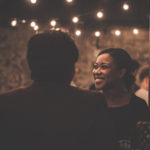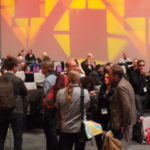We’re hardwired for story, neuroscientists say. It’s how we make sense of the information in our environment. But can a conference, which almost always includes a chorus of voices, use story to help present a coherent, cohesive narrative?
Yes, answers Hugh Lee, president of Fusion Productions, a 35-year-old events-services and production company that runs the annual digitalNow conference, which is dedicated to helping association executives navigate digital change. “Philosophically and approach-wise, the biggest difference, I think, between ourselves and many meetings is that we don’t approach [our work] as a product, as an event, or a meeting,” Lee said. “We approach it as a story. Story is our starting point.”
ONCE UPON A TIME
In an interview with Convene, Lee walked us through the nearly yearlong, intensely collaborative process that he and Fusion co-founder Don Dea use to create a story for digitalNow. For starters, Lee said, the story of a conference shouldn’t be confused with its theme — which at digitalNow 2016, held April 21–23 at the Hyatt Regency Orlando, was “Fearless.” “The theme is really more about how do we tap into [attendees’] emotions and their attitudes that come out of the story,” Lee said. “The story is tantamount to everything, it changes every year. That’s where you’ve got to roll up your sleeves and get the work done.”
That can’t be done in isolation. Fusion works with what Lee calls “the matrix” — a creative group that includes outside experts, digitalNow’s advisory board, the conference community, prospective speakers, and technology sponsors. “Everyone’s got to be involved to make the story come to life on site and after,” Lee said. “You just can’t sit down at your desk in your department and write the story.”
Lee and Dea begin preparing for the next year’s conference a matter of weeks after the most recent conference has ended, diving into research from sources outside the association world, in areas including technology, challenges facing CEOs and executive teams, and geopolitical issues. “We almost do a trends research study on what we think will affect association leadership in the digital age before we see it in the association industry,” Lee said. “If we wait till then, it’s too late.”

theme into his well-received closing-keynote talk.
After identifying major trends, Fusion conducts targeted conversations with people “who we consider to be forward-thinking members in our community,” Lee said, as well as a series of interviews with other sources they recommend. At about the six-month mark in the design process, Fusion creates a survey that goes out to their entire community, to make sure they get a wide variety of opinions. Data in hand, they conduct still more calls with the conference advisory group and select technology sponsors, who help interpret the results.
Only then, Lee said, does he distill the information into a narrative framework. “I pull all these trends, issues, fears, examples, and conversations together into a page-and-a-half to two-page white paper,” he said. “That becomes the driving storyboard and the structure for the overall story for the entire meeting.”
Fusion shares the document widely — it goes to every person on staff and the advisory group members, who sometimes share it with their staffs, as well as to prospective speakers. “It’s what we use in our one-to-one conversations from then on,” Lee said.
FEARLESSNESS ITSELF
During pre-conference conversations for digitalNow 2016, Lee and Dea’s research showed that the conference community understood how profoundly mobile, social, and cloud technology has changed the landscape. “But some of their leadership and staff get it and some don’t,” Lee said, “which is a change issue and training issue.” There were also worries about governance, as well as issues around preserving or replacing longstanding sources of revenue that both technology and generational shifts are dramatically changing.
“As we started pushing deeper into those issues, the word that kept coming back was ‘fear,’” Lee said. “And when we talked to the people we thought were the thought leaders in the industry, what they were coming back with in some way was saying, ‘You have to fear [these issues]. You have to understand that if you don’t do these things, you’re going to collapse, you’re going to end up losing anyway, so you have to create a pathway to that new world and be fearless about it.’”
Fear vs. fearlessness became the narrative. “The issues, the content that we’re creating this year, the doorway into the fearless,” Lee said. “And that’s where keynote speakers came in.” In his remarks, the closing speaker — Netflix cofounder and former CEO Marc Randolph — said: “You’ll never know [the future], but you have to be fearless.” “He took that right from the white paper,” Lee said.
On site, Lee and Dea keep up a running conversation centered on the story throughout the event, incorporating it into video from the stage. “We do that to give people a sense that, ‘Oh, this is all coming together. I can see how this is tying in together,’” Lee said. “More importantly, they get the idea that, ‘Hey, this is my meeting, this is my story.’”
ALL-STAFF ALL-STARS
Early-morning, all-staff meetings, a mainstay for many event teams, aren’t part of the Fusion Productions process. “My favorite phrase to my staff — and I mean this positively — is ‘We’re not in the business of putting on events, we’re in the business of driving meetings of value,’” said Lee. “‘The logistics are not what I want you talking about. I want you out in the morning talking to people at breakfast, finding out what their issues are.’ I say, ‘Sit at a separate table, don’t sit together. Find out how [attendees] are receiving the content, what questions do they want, what suggestions do they have? Become part of the community.’”
Lee and Fusion’s Don Dea hold a 30- to 45-minute meeting after the close of each day’s education, where the feedback that staff has gotten from attendees is entered into a Google Doc spreadsheet on the spot. “I challenge the staff: ‘Find one thing that we can change,’” Lee said. “Even if everything is going perfectly, find one thing I can stand up on the stage and say, ‘Hey, I spoke to so-and-so yesterday and she said this, so here’s what we’re going to do to make this better.’



